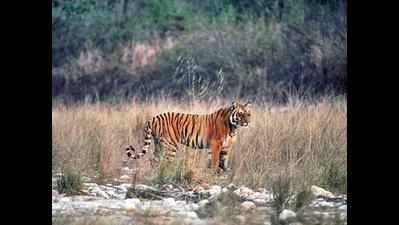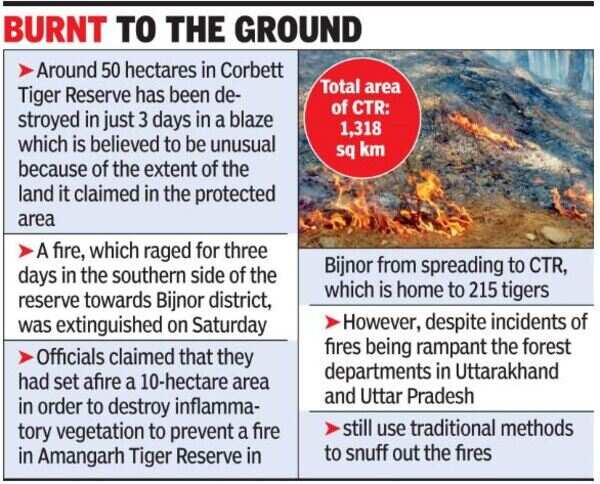- News
- City News
- dehradun News
- 50 hectares of Corbett Tiger Reserve go up in smoke, fire threat still looms large
Trending
This story is from April 16, 2016
50 hectares of Corbett Tiger Reserve go up in smoke, fire threat still looms large
Around 50 hectares in Corbett Tiger Reserve (CTR) has been destroyed in just three days in a blaze which is believed to be unusual because of the extent of the land it claimed in the protected area.

Around 50 hectares in Corbett Tiger Reserve (CTR) has been destroyed in just three days in a blaze which is believed to be unusual because of the extent of the land it claimed in the protected area.
BIJNOR/DEHRADUN: Around 50 hectares in Corbett Tiger Reserve (CTR) has been destroyed in just three days in a blaze which is believed to be unusual because of the extent of the land it claimed in the protected area.
The raging inferno had started at the southern side of the reserve towards Bijnor district. CTR is home to 215 tigers.
Principal chief conservator of forests DVS Khati confirmed the fire and its extent, but said it was under control.However, there seems to be no relief for CTR administration just yet as a massive fire that had broken out in Sahuwala forest range in Najibabad division on Friday is still raging. This range lies in close proximity to CTR.
The CTR administration has been on its toes as it also had to battle a blaze in the Kalagarh division, which destroyed 14 hectares of forest land, in the past few days. Electric wire-crossing in the forest could have sparked the fire, officials said. Another major fire in Saptdhuli range which burnt 26 hectares has, meanwhile, been brought under control, officials said.
Khati added that the fires are mostly extinguished using the fire line method, where a patch of forest is cleared of any dry vegetation which is inflammable.Tiwari added that difficult terrain in the hills and shortage of staff poses challenges in controlling fires which can spread faster in the summer due to high wind speeds.
"Loss to wildlife is yet to be ascertained but it is believed that wild animals must have rushed to safer locations," Tiwari said. Wildlife experts, meanwhile, have expressed concerns about safety of tiger cubs and babies of other animals who can fall victim to the fire.
This came even as efforts were on to control the blaze in Sahuwala range of Najibabad division. DFO (Bijnor) Saleel Kumar Shukla said, “The fire broke out on Friday. It is believed that someone may have thrown a lit bidi or cigarette. Forest department is engaged in extinguishing the fire and dry leaves are being cleaned.”

As fires are more common during the intense summer heat, forest authorities need to regularly remove dry leaves that easily catch fire due to preheating. However, despite incidents of fires being rampant, forest departments in Uttarakhand and UP still use traditional methods to snuff out the fires.
DFO Bijnor said that fire brigades cannot be called to douse the flames in forest areas as they can carry a limited amount of water. “To put out the fire by removing dry leaves is one of the safest methods of minimizing its spread. Besides, we hold regular meetings with villagers to motivate them to become stakeholders in safeguarding the forest from fire,” he said.
The fires displace wildlife, often pushing leopards, wild boars, and deer, etc, towards human settlements, which leads to increased cases of man-animal conflict. Villagers living in vicinity of the protected Amangarh reserve and CTR said that they have to bear the brunt of fires which lead to loss of animal habitat.
According to Rajendra Singh, a farmer in Gadhla, near Sahuwala, "Forest fires compel wild animals to intrude into agricultural fields and villages. It becomes really dangerous to work in the fields during this time."
The raging inferno had started at the southern side of the reserve towards Bijnor district. CTR is home to 215 tigers.
Principal chief conservator of forests DVS Khati confirmed the fire and its extent, but said it was under control.However, there seems to be no relief for CTR administration just yet as a massive fire that had broken out in Sahuwala forest range in Najibabad division on Friday is still raging. This range lies in close proximity to CTR.
The CTR administration has been on its toes as it also had to battle a blaze in the Kalagarh division, which destroyed 14 hectares of forest land, in the past few days. Electric wire-crossing in the forest could have sparked the fire, officials said. Another major fire in Saptdhuli range which burnt 26 hectares has, meanwhile, been brought under control, officials said.
Ramakant Tiwari, wildlife warden, Uttarakhand, said, “Three major fires took place in Corbett. This includes one in Jhirna range engulfing 10 hectares, another in Kalagarh burning some 14 hectares, and third in Saptdhuli gutting 26 hectares of forest land in the past three days.”
Khati added that the fires are mostly extinguished using the fire line method, where a patch of forest is cleared of any dry vegetation which is inflammable.Tiwari added that difficult terrain in the hills and shortage of staff poses challenges in controlling fires which can spread faster in the summer due to high wind speeds.
"Loss to wildlife is yet to be ascertained but it is believed that wild animals must have rushed to safer locations," Tiwari said. Wildlife experts, meanwhile, have expressed concerns about safety of tiger cubs and babies of other animals who can fall victim to the fire.
This came even as efforts were on to control the blaze in Sahuwala range of Najibabad division. DFO (Bijnor) Saleel Kumar Shukla said, “The fire broke out on Friday. It is believed that someone may have thrown a lit bidi or cigarette. Forest department is engaged in extinguishing the fire and dry leaves are being cleaned.”

As fires are more common during the intense summer heat, forest authorities need to regularly remove dry leaves that easily catch fire due to preheating. However, despite incidents of fires being rampant, forest departments in Uttarakhand and UP still use traditional methods to snuff out the fires.
DFO Bijnor said that fire brigades cannot be called to douse the flames in forest areas as they can carry a limited amount of water. “To put out the fire by removing dry leaves is one of the safest methods of minimizing its spread. Besides, we hold regular meetings with villagers to motivate them to become stakeholders in safeguarding the forest from fire,” he said.
The fires displace wildlife, often pushing leopards, wild boars, and deer, etc, towards human settlements, which leads to increased cases of man-animal conflict. Villagers living in vicinity of the protected Amangarh reserve and CTR said that they have to bear the brunt of fires which lead to loss of animal habitat.
According to Rajendra Singh, a farmer in Gadhla, near Sahuwala, "Forest fires compel wild animals to intrude into agricultural fields and villages. It becomes really dangerous to work in the fields during this time."
End of Article
FOLLOW US ON SOCIAL MEDIA










